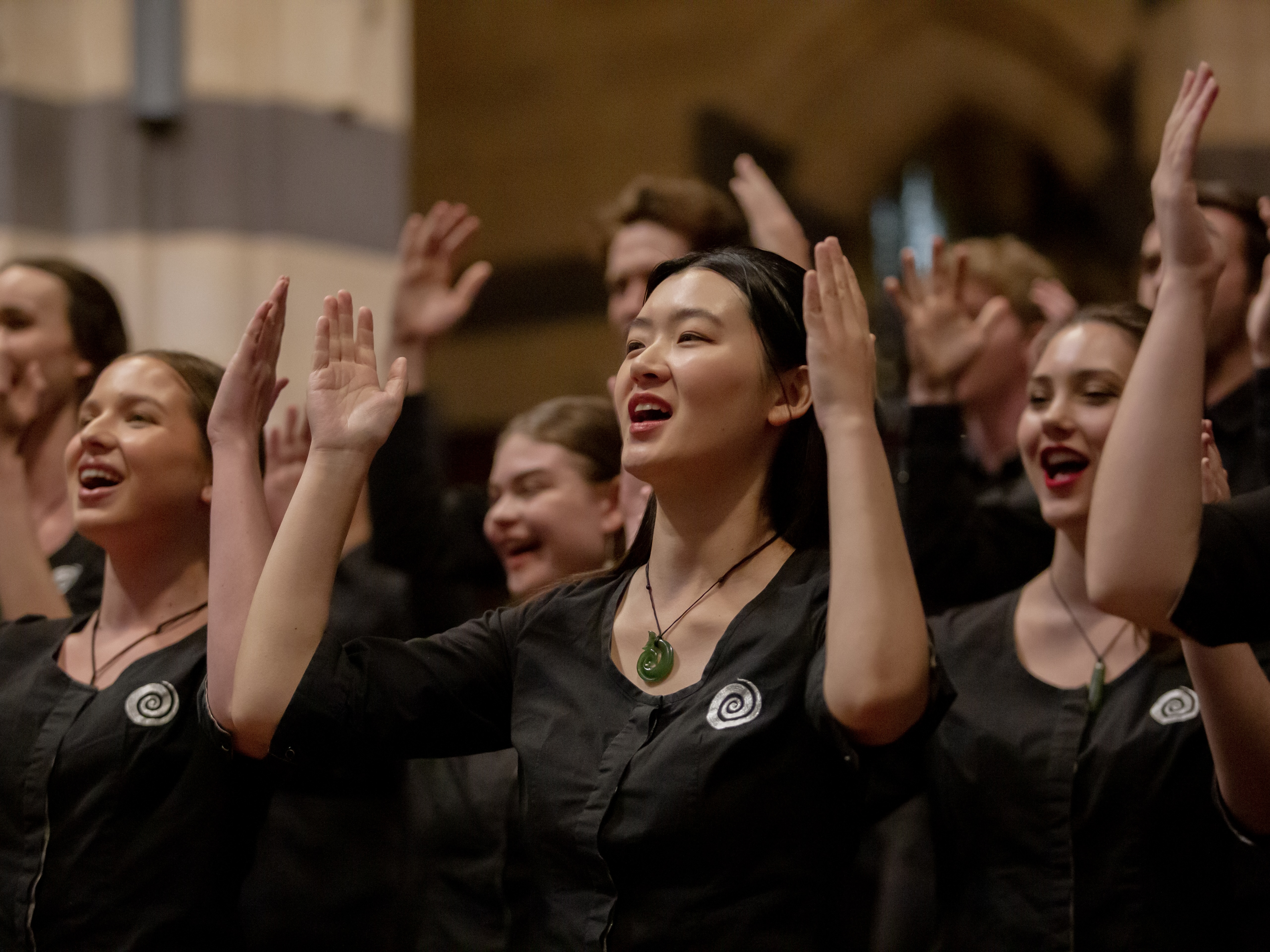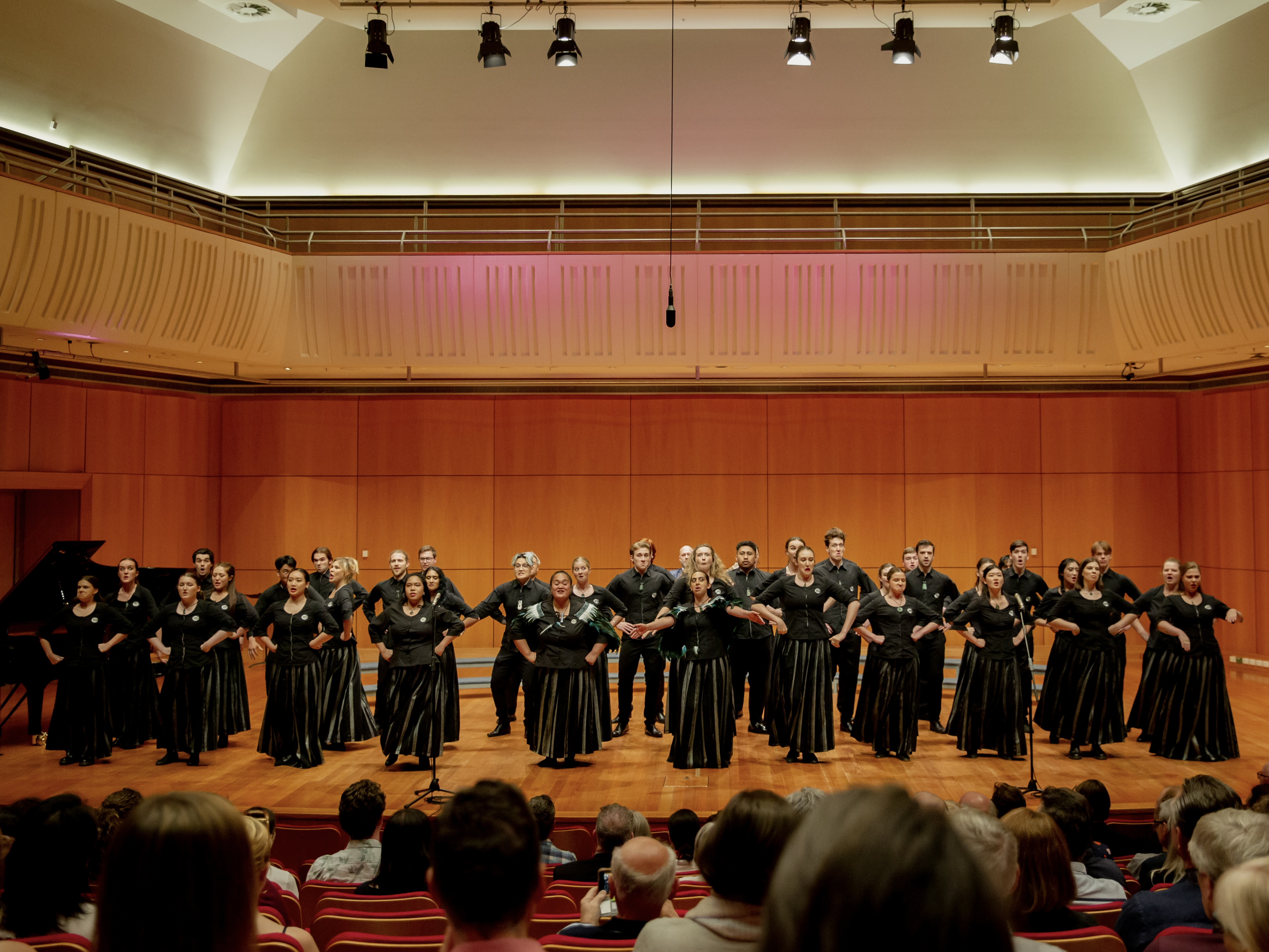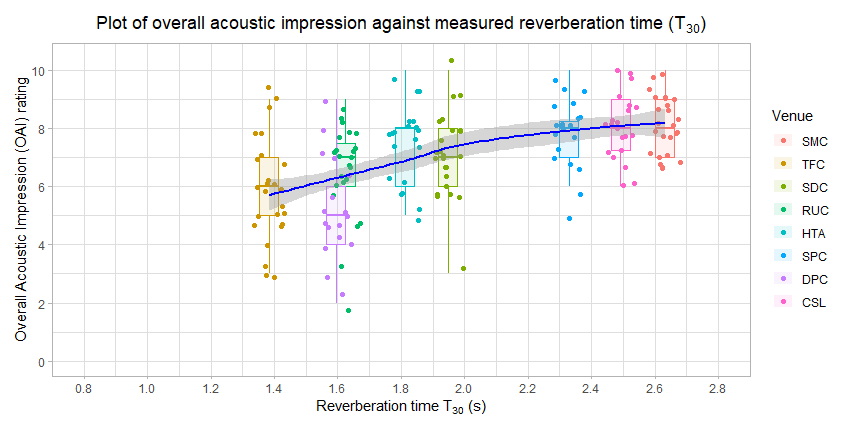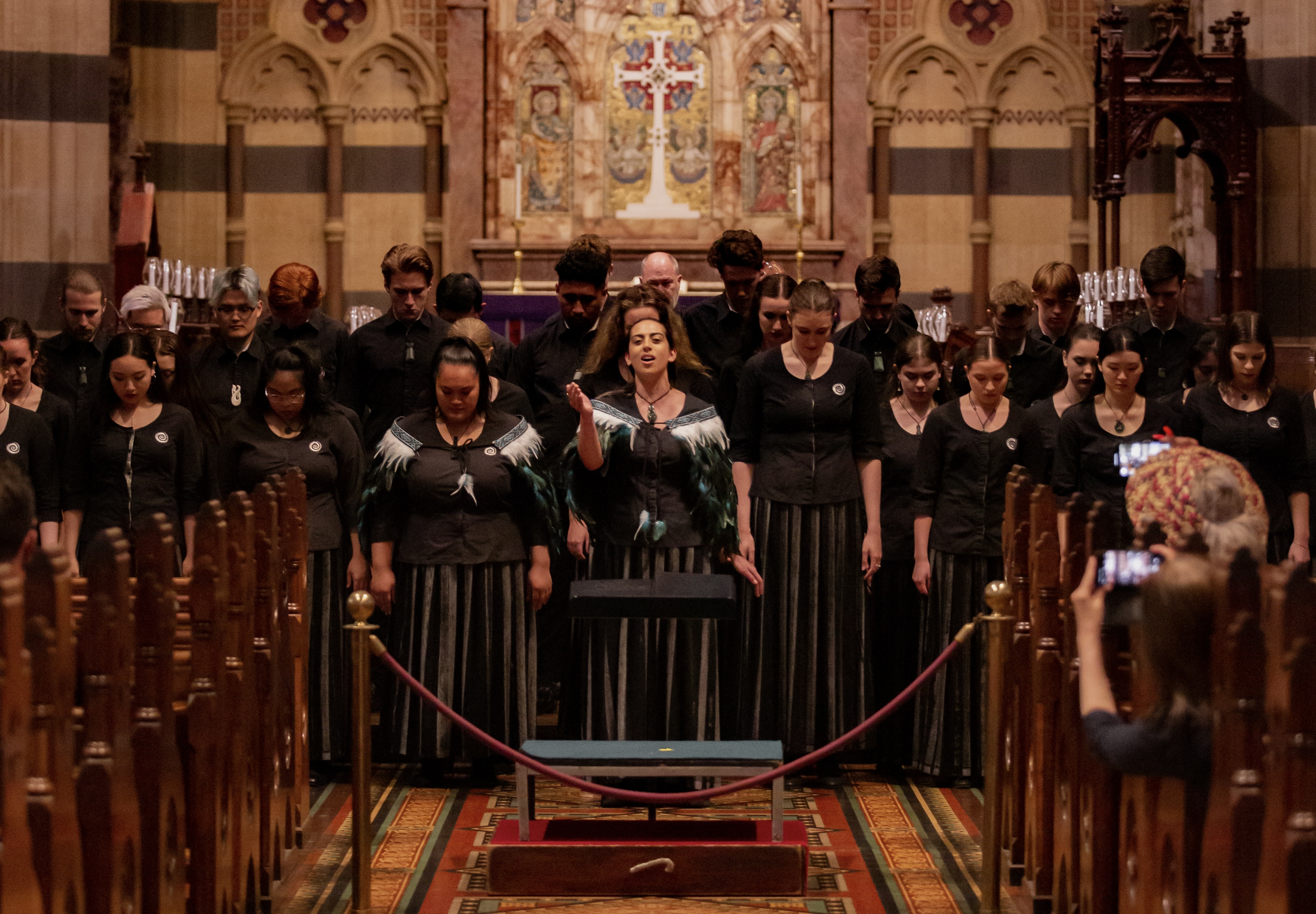
The clarity factor: A new study on choral acoustics
27 May 2024

Acoustic engineer and longtime chorister Maggie Zhang recently published a report titled 'Investigations into Choral Singers' Perception of Stage Acoustics During an Australian Tour'.
Based on measurements and survey responses collected during the New Zealand Youth Choir's Australian tour in November and December of 2022, the report is a deep dive into how choral singers feel about the spaces they perform in. We asked Maggie (pictured above with the New Zealand Youth Choir) a few questions about the study, and about her various experiences in the realms of acoustics and music.
Tell us about your life as a chorister - what got you into choirs, which ones do you currently sing in, and what have been the highlights along the way?
The unofficial story is that a family friend challenged me to SingStar on the Play Station 2 in Year 7, and after a couple of rounds told me 'You should do choir.' The official story is that I then went on to sing in the choirs at Burnside High School, in which I discovered the world of choral music. After moving up to Auckland for university, I joined the Auckland Youth Choir and later the New Zealand Youth Choir. At my no-longer-youthful age of 27, I now sing in the Auckland Chamber Choir. Some highlights are winning the Platinum award at The Big Sing in 2012, the AYC New York trip and meeting Paul Mealor in 2016, the AYC performance of Annelies in the Auckland War Memorial Museum in 2018, the NZYC Pacific tour in 2019, and the NZYC Eric Whitacre project in 2022.
What prompted you to bring the professional and choral parts of your life together for this study? Is that something you’d be keen to do again?
As a mechanical engineering student, I attended a seminar by Lily Panton hosted by the Acoustical Society of New Zealand. It was on Lily's PhD thesis, 'Investigating auditorium acoustics from the perspective of musicians', in which she surveyed Australian Chamber Orchestra musicians on their impressions of concert venues on tour and measured the acoustics of the spaces. After completing my final year engineering project and starting work as an acoustic engineer at Marshall Day Acoustics, I didn't really expect to do any more research. But I guess Lily’s study had stuck in my mind, and when we were a few months out from the NZYC 2022 Aussie tour, I wondered, 'Could I turn this into a research project?' After digging through some literature, it seemed like no one had done a study on choral singers’ acoustic impressions on a tour - so I felt pretty confident that I could come up with some interesting conclusions.
This felt like a 'right place, right time' situation. I’m not jumping at the idea of doing more research, as I find the consulting part of my job more enjoyable and fulfilling. However, I’ve had a few good responses on my project from academics and consultants around the world who are much more established in the field of stage acoustics than I am. So, hopefully I’ve made my small contribution to our collective understanding of choral singer perception.

Could you summarise your findings in a nutshell? Were you surprised by the results?
The main conclusion is that the singers liked the venues with the longest reverberation times, specifically between 2.2–2.6 seconds. For some context, St Matthew-in-the-City in Auckland is 2.6 seconds. This was not a surprising conclusion – we’re all familiar with the suggestion of 'Let’s go to the lobby/stairwell/carpark to rehearse this'. Encouragingly, this conclusion aligned quite well with recommendations in existing literature for choral music.
The highly rated venues were also highly rated for visual impression. This made sense when looking at our venues: the historical churches and contemporary auditoriums were highly rated for both. A cool-looking building does not equal good acoustics, but it will probably contribute to the overall concert experience for the singer and the audience.
Surprisingly, the singers did not seem to like high levels of early reflections [the first sound waves that bounce off a room's surfaces]. There have been many studies over the last few decades showing that instrumentalists generally prefer moderate levels of early reflections. In many concert halls, including those in NZ, you can see suspended reflectors above the stage where the orchestra would be. These help musicians hear themselves better, particularly when the concert hall is very large. The established general understanding is that singers are influenced much more by reverberation than early reflections, and that both contribute positively to the performer’s experience. In contrast, my data showed that the singers reacted negatively towards early reflections. I think this area will need a bit more research before I start making some controversial statements.

What difference do you think this study could make for choirs – in Aotearoa, or internationally?
I think there may be a few levels to this.
I’m hoping that it would encourage choir directors and singers to think more critically about the acoustics of the spaces that they are performing in. Community choirs, in particular, often don’t have the resources to hire venues particularly suited for singing. There may be opportunities to explore non-traditional venues instead. Choral directors may also consider the acoustic properties of their venue when selecting repertoire.
I've also been wondering whether the choral shell needs a bit of a rethink. Its purpose is to increase the amount of reflected sound from the choir to the audience. Based on the conclusions from my study, I wonder whether the shape or positioning of the choral shell should be redesigned to benefit both the audience and the performers.
In terms of designing new venues, the difficulty with multi-purpose spaces in particular is that they need to be suitable for speech and drama, dance, classical and contemporary music, etc. The preferred reverberation times for choirs are so much higher than for the other arts forms, that these spaces are deemed 'dry' and 'bad', and as a result, the choral community avoids them.
There are ways of increasing the reverberation time without completely changing the building design, by including operable features such as large reflective surfaces that can be revealed or covered by heavy absorptive theatre drapes. One of the school auditoria we performed at during the Australian tour had these, but we didn’t know about them until after the concert. A missed opportunity – they likely would have made a noticeable difference in increasing the reverberation time.

Was there anything particularly challenging – or particularly enjoyable! – about undertaking this study while touring with NZYC?
Being a singer on tour and doing a project at the same time was a bit of a logistical challenge. I had to turn up early or stay late after concerts to do measurements. Luckily, my equipment was pretty portable – about the size of a carry-on suitcase, which was actually designed in-house by my colleagues.
I was pleasantly surprised by the level of interest from the singers. It was encouraging to see them listen critically to the performance spaces and engage with the topic.
The most challenging part of the study was the sheer amount of statistical modelling I had to do with the data. I first had to figure out which models could help me answer my research question, and if they were suitable for the type of data I had. Then I had to teach myself how these models worked, and how to implement them, which involved a few weeks of writing code. I’m very happy with how my plots turned out though – I think they tell a good story.
Has music snuck into your engineering work before this?
I’ve been to a number of music festivals and stadium concerts which usually happen over the summer months. My role is to measure the sound levels at the sound desk and at the closest houses, to make sure that the levels are within the limits in their resource consent. It’s a lot less glamorous than it sounds, as most of the time I’m just standing in a muddy paddock in the dark with my sound level meter while getting bitten by mosquitoes. (It does mean that I sometimes get to see some pretty big international artists for free, though.)
I’d also like to take this opportunity to make a public service announcement: Please wear hearing protection at loud concerts and other noisy environments! Hearing loss is irreversible with our current medical capabilities, and is a pretty big public health problem.
The only performing arts design project which I’ve had an active involvement in is a new multi-purpose cultural centre in Whangārei. We’re not building a new auditorium in New Zealand every month, so most of my projects are related to infrastructure and commercial and residential buildings.
Finally – what’s been your favourite venue to sing in?
During the tour, it was definitely Ian Roach Hall at Scotch College, Melbourne. There was an effortless warmth to the sound that I don’t think I’ve experienced anywhere else.
Those of us that live in Auckland have the privilege of having access to St Matthew-in-the-City. I think many of us take it for granted just how good a venue for choral music it is.
Last year, four friends and I put on a concert Byrd and Beyond (all Renaissance pieces) in the University of Auckland Clock Tower. That was a memorable venue due to how small but also reverberant the space was, which created an all-encompassing sound-bath experience.
Credit for all photos goes to Lucas Packett Photography.
